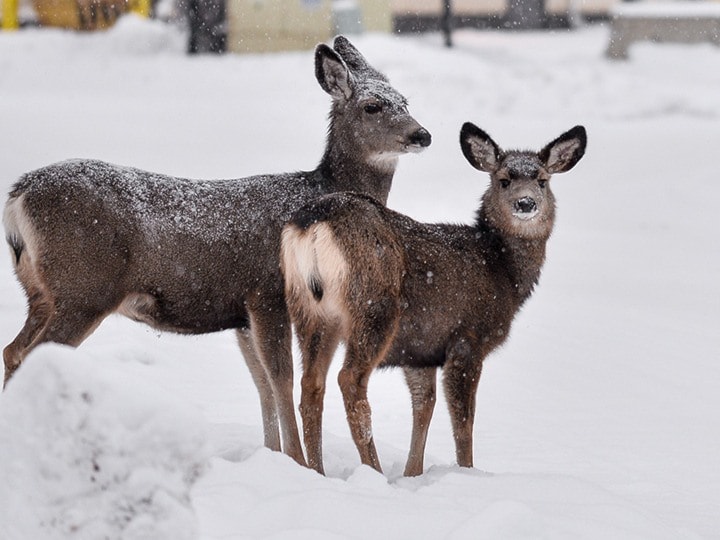By Ezra Black
The District of Elkford is turning to residents to decide whether or not to proceed with its second deer cull in three years.
To that end, Elkford’s council has scheduled a public forum to be held Jan. 18 and approved the distribution of a survey on urban deer at a Jan. 9 meeting.
Residents are being asked to disclose their experiences with urban deer over the past five years. The results will be made public.
The survey can be completed online and residents are being asked to submit their answers no later than Feb. 1, at which point council will decide on whether to proceed with a cull.
Elkford conducted a similar survey in 2010 where about 70 per cent of the 433 respondents said they wanted to see a 30 to 40 per cent decrease in Elkford’s deer population.
About 48 per cent of respondents said they were very concerned about the deer population in the community, 73 per cent of respondents said their main concern was deer aggression toward humans and over fifty-five per cent of respondents said that they, or a member of their immediate family had been threatened by a deer.
Most of the threatening ungulates were female and most of the incidents occurred in the summer.
Respondents said conflicts with pets and vehicular collisions were a concern, as was damage to gardens with a majority of respondents saying they had lost flowers, shrubs and trees to deer.
Between 2011 and 2016 the District of Elkford completed five deer counts. The last one was conducted in November of last year and found 59 deer.
But are the doe-eyed ungulates really so dangerous? That depends on the time of year and how frightened they are of humans said Joe Caravetta, an inspector with the B.C. Conservation Service's Kootenay-Boundary region.
“Typically deer are not considered dangerous wildlife,” said Caravetta. “However they are a wild animal and as such can be unpredictable.”
A deer’s dangerousness depends on the season. In the summer months they become very protective of their young. In the fall, their mating season, they can become protective of their herd, said Caravetta.
In early 2014, Elkford culled 39 mule deer. Caravetta said the deer were captured alive and then euthanized by a contractor. Attempts were made to target deer that had been identified as aggressive.
The meat from the culled deer was provided to food banks.
Deer culls are one tool to address the issue. According to a municipal release, Elkford has been considering a number of other management options. These include frightening the deer with loud noises, keeping them away with repellents, public hunting, fencing, public education and relocation.
During February and March of last year, 60 deer were relocated from Cranbrook, Kimberley, Invermere and Elkford. Twenty-nine of the deer were fitted with radio collars to allow monitoring of their movements and survival rates.
The 15 deer captured in Elkford were released on the south side of Mount Broadwood, said Ian Adams, senior wildlife biologist with VAST Resource Solutions Inc.
“We want to follow them for a full year before we make any decisions as to whether translocation could be an option as a management tool,” he said.
Adams said early results show the survival rates of the collared animals have been comparable to the general deer population.
“We’ve had mortalities,” he said. “There were a few predation events in the late spring but that is a time when non-urban mule deer populations have their highest levels of mortality.”
Previous studies have been done to see if relocation is an effective deer management tool but quite often they were not successful, said Adams, however the province is trying again because the drugs used to sedate deer for capture have improved.
“They’re much better for the deer,” said Adams. “Our success at capturing and moving them was quite good. We are very pleased with how that process went.”
Adams said the research should be completed sometime in 2017.
During the last meeting of Elkford’s Urban Wildlife Management Advisory Committee, one citizen asked if castration of bucks was a viable option to control deer.
However, the Ministry of Forests, Lands and Natural Resource Operations said castrating the bucks would be alarming for deer and labour intensive for humans.
Castration would require capture, an anesthetic and invasive surgery by a veterinarian. Every buck in the community would have to be castrated, as each can service multiple females. There would be a number of effects on antler development, said the ministry in a statement.
Bucks habituated to humans would still be a safety risk. The does would continue to have estrous cycles, attracting new bucks. The population behaviour and structure would be affected, it continued.
In early December, Elkford was one of several B.C. municipalities that was approved for a grant under a provincial program launched last year to support local government’s that are experiencing challenges with urban deer.
Elkford received $10,000 to cull 50 deer in the community.
Invermere was approved for $10,200 to cull 51 deer and Grand Forks will receive $16,000 to cull 80 deer. An application from Oak Bay is still under consideration.
